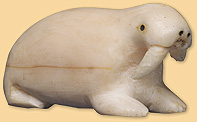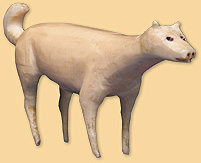 |
This collection was purchased from the widow of Duncan G. Burgess
in 1930. Although the CMC Archives has the complete correspondence
between Mrs. Burgess and Diamond Jenness, then Chief of the Division
of Anthropology, it is nowhere stated under what conditions these pieces
were collected. However, it is clearly documented that they were made
in the area of Fort Chimo, now Kuujjuaq, before 1930.
The collection allows comparison with two others. Both the Paul
Bonard collection, and Edward Caldwell's, are from Fort Chimo and have
tusks carved in the round similar to the one in the Burgess
collection.

Carved Walrus Tusk, before 1930
Kuujjuaq (Fort Chimo), Nunavik
Ivory, black colouring
6.5 x 40 x 3 cm
CMC IV-B-623
Collected by Duncan G. Burgess
|
 |
The originator of this large impressive work, sculpted in the round,
probably used an entire walrus tusk. The black dots, marking the feathers
of an owl, are reminiscent of carved tusks collected by Caldwell in 1914.
Anthropologist Frank Speck discusses works in a similar style from the
1920s, also from this region, and now at the American Museum of Natural
History.* It looks as if there is an unbroken tradition going back as
early as 1904, when Paul Bonard collected his tusks in the Ungava region.
*Frank Speck
1927 – "Eskimo Carved Ivories from Northern Labrador."
Indian Notes, vol. 4, #4, pp. 309-314.
References:
Martijn, Charles
1967 – "A Retrospective Glance at Canadian Eskimo Carving."
Beaver Magazine. Autumn 1967, ill. p. 10.
 |
Walrus, before 1930
Kuujjuaq (Fort Chimo), Nunavik
Ivory, black colouring
2.1 x 4.3 x 1.8 cm
CMC IV-B-629
Collected by Duncan G. Burgess
|
 |
Although a charming creature, this diminutive walrus may well have
started out as a child's toy. The hind flippers are fully carved
underneath, indicating that it was meant to be held and looked at from
all sides.
Standing Woman, before 1930
Kuujjuaq (Fort Chimo), Nunavik
Ivory, colouring
10 x 3 x 3 cm
CMC IV-B-626
Collected by Duncan G. Burgess
|
|
 |
 |
Although fairly large, this crude representation of a woman, with
neither hands nor feet, was presumably made as a toy. This assumption
is supported by the fact that the face has not been sculpted, but
painted. It seems that the figure's maker was not inclined to devote
much time to its creation.
 |
|
Dog, before 1930
Kuujjuaq (Fort Chimo), Nunavik
Ivory, black colouring
2.6 x 5.5 x 0.9 cm
CMC IV-B-630
Collected by Duncan G. Burgess
|
 |
With its head raised, and its tail and ears alert to what is going
on around, this animal seems to have a personality of its own. It is
far from a generic depiction of a dog. Is this a portrait done by its
owner?
|